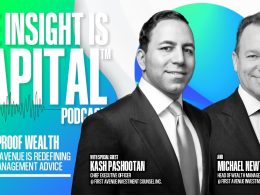by Liz Ann Sonders, Senior Vice President, Chief Investment Strategist, Charles Schwab & Co
Key Points
- On the one hand, payrolls beat expectations; on the other hand, the unemployment rate ticked up.
- On the one hand, the labor force is increasing; on the other hand, wage growth remains somewhat tepid for this stage in the cycle.
- On the one hand, job openings have rolled over; on the other hand they remain above the number of unemployed persons.
President Harry Truman once wished for a “one-handed economist.” The thinking behind that quip can be applied to the latest readings on the U.S. labor market. On the one hand, we got a better-than-expected January jobs report last Friday; but on the other hand, there was plenty in the details of the data with which to quibble. Particularly when you’re in the latter part of the cycle, labor market data take on increasing importance as they impact expectations about the growth trajectory, monetary policy, income/spending, inflation and consumer confidence.
Sustainable gains?
Non-farm payrolls from the Bureau of Labor Statistics (BLS) were up 225k last month—well north of the 158k consensus estimate by economists—with a net 7k upward revision to the prior two months’ payrolls. However, the fifth warmest January on record meant some of the payroll gains may not be sustainable: construction and leisure/hospitality—with 44k and 36k payroll gains, respectively—were clear and direct beneficiaries of weather. On the other hand, manufacturing payrolls dropped by 12k and are down in three of the past four months, led by cuts in vehicle production.
As you can see in the chart below, since peaking in 2014, average monthly payrolls have been generally trending down (with the exception of a pop in 2018). In fact, 2019’s monthly average of 175k was the lowest since 2011. This data is inclusive of the annual benchmark revisions by the BLS, which shaved 514k payrolls for the 12 months ending March 2019. On the other hand, although payroll gains pre-March 2019 were revised down substantially, payroll gains between April and December last year were revised up by 92k.
Payroll Growth Persists

Source: Charles Schwab, Bloomberg, Bureau of Labor Statistics, as of 1/31/2020.
The latest three-month moving average of 211k payroll gains remains well in excess of what is required to keep the unemployment rate from rising by any meaningful degree, as you can see in the chart below. This should provide some buffer for some of the coming hits to employment from the knock-on effects of the Coronavirus. Payroll reports cover the pay period containing the 12th of each month, which means the effects of the virus have yet to be felt (it wasn’t until January 7 that the World Health Organization identified the virus as 2019-nCoV).
Payroll Growth Strong Enough to Keep UR Steady

Source: Charles Schwab, Bureau of Labor Statistics, Federal Reserve Bank of Atlanta, as of 1/31/2020.
AHE higher, but historically uninspiring
The average workweek was unchanged at 34.3 hours—toward the lower end of its range since 2011. But average hourly earnings (AHE) edged up by 0.2% last month, for a year/year gain of 3.1%. That level is historically tepid for this stage in the expansion, especially with a 3.6% unemployment rate (which ticked up from 3.5% last month). The chart below compares AHE for production and nonsupervisory workers (which has a longer history than total private sector AHE) to the unemployment rate. As an aside, the AHE for production/nonsupervisory workers is at 3.3% year/year vs. a lesser 3.1% year/year inclusive of those workers’ supervisors.
As you can see below, at least for the past three cycles, the points at which the unemployment rate and AHE had converged and/or crossed, were typically just in advance of recessions. Caveat: there was an “early warning” in mid-1998; yet there remained a 3-year runway before the subsequent recession.
Wages and Unemployment Rate Converging

Source: Charles Schwab, Bloomberg, Bureau of Labor Statistics, as of 1/31/2020. *Average hourly earnings for production and nonsupervisory workers.
Tight labor market persists
In terms of the slowdown in payroll growth, it does partly reflect the tightness in labor market conditions, including insufficient skilled labor supply and related recruiting difficulties. As you can see below, at least for smaller businesses, the number one problem cited in the monthly survey by the National Federation of Independent Business (NFIB) is “quality of labor.”
NFIB’s Single Most Important Problem

Source: Charles Schwab, Bloomberg, as of 12/31/2019. National Federation of Independent Business (NFIB).
The moderation in payroll growth is also typical during latter stages in economic cycles. As the largest net job creators, smaller businesses hiring plans are also worth watching. As you can see in the chart below, they have been generally trending down since peaking in late-2017.
Small Businesses Plan to Hire Less

Source: Charles Schwab, Bloomberg, as of 12/31/2019. National Federation of Independent Business (NFIB).
LFPR continues to accelerate
The most positive chapter in the jobs story continues to be the acceleration in the labor force participation rate (LFPR)—which swelled by 574k last month; bringing the rate to 63.4%, which is the highest since June-2013. Prime-age (25-54) participation rose to 83.1%, the highest since August 2009; with the women’s portion rising to 77.0%, the highest since May 2000. Finally, the employment/population ratio rose to 61.2%, the highest since November 2008. On the other hand, there is a long way to go before reaching the early-2000 peak in the LFPR, as you can see in the chart below.
Labor Market Attracting More People

Source: Charles Schwab, Bloomberg, Bureau of Labor Statistics, as of 1/31/2020.
Less positive chapters in the jobs story are temporary employment growth and the rate of job openings. Temporary employment growth is considered a leading indicator, and it has stalled; with persistent year/year declines for more than a year as you can see below.
Tepid Temporary Employment

Source: Charles Schwab, Bloomberg, Bureau of Labor Statistics, as of 1/31/2020.
Job openings have also rolled over, as you can see in the yellow line in the chart below. On the other hand, openings remain comfortably above the number of unemployed persons in the United States—notwithstanding the aforementioned skills gap problem.
Job Openings Rolling Over

Source: Charles Schwab, Bloomberg, Bureau of Labor Statistics. Unemployed persons as of1/31/2020. Job Openings and Labor Turnover Survey (JOLTS), as of 11/30/2019.
We are keeping a close eye on job openings. Economists at the Federal Reserve are concerned that last year’s weakness in manufacturing could morph into broader economic weakness (ending the “bifurcation” in the economy about which we’ve been writing for some time). Where job openings lead, payrolls (and wage growth) generally follow; culminating in a rising unemployment rate and ultimately a recession. We’re not there yet, thanks to healthy consumer confidence and historically-low unemployment claims (a key leading indicator), as seen in the chart below; but we need to be on guard for any coming deterioration.
Claims Still Historically Low

Source: Charles Schwab, Bloomberg, Department of Labor, as of 1/31/2020.
Fed policy and GDP growth implications
The stronger-than-expected labor market momentum heading into the heart of the Coronavirus shock is welcome news. On the other hand, the Federal Reserve is likely to consider a rate cut at one of the upcoming Federal Open Market Committee (FOMC) meetings—possibly as soon as next month, assuming the virus shock starts to have a meaningful impact on growth. With limited wage and/or inflation pressures, the Fed should feel some flexibility with regard to the current “on hold” status in the interest of focusing on its full employment mandate.
Courtesy of the pick-up in the LFPR and the recent uptick in productivity growth, potential gross domestic product (GDP) growth continues to accelerate. This could represent a bit of a buffer to the extent the effects of the Coronavirus continue to escalate.
Copyright © Charles Schwab & Co














